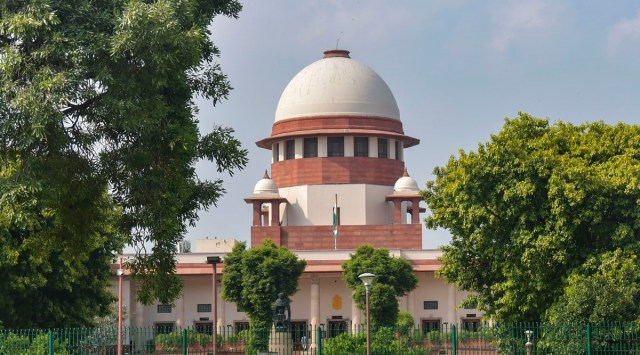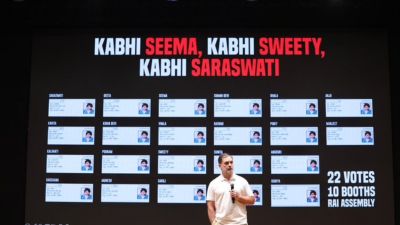Hearing on challenge to Art 370 starts, SC has queries on nature of provision, powers
Chief Justice of India D Y Chandrachud, presiding over a five-judge Constitution Bench which began hearing the petitions, pointed out that Article 370 was placed in Part XXI of the Constitution which deals with “temporary, transitional and special provisions”.
 The top court is conducting day-to-day hearing in the matter and will hear arguments except on Mondays and Fridays. (PTI Photo)
The top court is conducting day-to-day hearing in the matter and will hear arguments except on Mondays and Fridays. (PTI Photo) Questioning petitioners who have challenged changes made to Article 370 of the Constitution on their contention that the provision which granted special status to J&K was meant to be temporary until the Constituent Assembly for the erstwhile state took a decision one way or the other, the Supreme Court Wednesday sought to know who decides when no Constituent Assembly exists there.
Chief Justice of India D Y Chandrachud, presiding over a five-judge Constitution Bench which began hearing the petitions, pointed out that Article 370 was placed in Part XXI of the Constitution which deals with “temporary, transitional and special provisions”.
“Temporary are those which are intended to be in existence for a limited period of time but without a point of terminus. Transitional means something which necessarily has a terminus. Third is special… It doesn’t use the expression ‘transitional’ in any headnote or marginal note to the Article. But ‘temporary’ and ‘special’ are used in the marginal notes. And 370 specifically uses the expression temporary… Can we then, by saying that power under Clause 3 (President’s power to abrogate) goes once the Constituent Assembly comes to an end, really convert this into a permanent provision which it was never intended to be by the Constitution?” the CJI asked Senior Advocate Kapil Sibal who opened the arguments on behalf of the petitioners.
Sibal told the bench, also comprising Justices S K Kaul, Sanjiv Khanna, B R Gavai and Surya Kant, that “when 370 was put in, it had to be a temporary provision. There was nothing there at that point in time”.
“Then why did the Constitution put it in Part XXI?” the CJI asked.
 New Delhi: Former J&K chief minister Omar Abdullah and J&K National Conference MP Hasnain Masoodi at the Supreme Court complex, in New Delhi, Wednesday, Aug. 2, 2023. The apex court has commenced hearing petitions challenging the abrogation of Article 370 of the Constitution that gave special status to the erstwhile state of Jammu and Kashmir. (PTI Photo)
New Delhi: Former J&K chief minister Omar Abdullah and J&K National Conference MP Hasnain Masoodi at the Supreme Court complex, in New Delhi, Wednesday, Aug. 2, 2023. The apex court has commenced hearing petitions challenging the abrogation of Article 370 of the Constitution that gave special status to the erstwhile state of Jammu and Kashmir. (PTI Photo)
Sibal said, “Because it’s separate. It relates to a particular state where the two sovereigns have come together and made a compact which is incorporated.”
Justice Gavai pointed out that Part XXI does not deal only with J&K.
Sibal said, “That’s why I said it’s a separate independent provision and has to be interpreted on its own terms. You can’t incorporate concepts outside of 370 and integrate into 370 and say this is how we will read 370. 370 is not temporary.”
The CJI pointed out that the marginal “note (to the Article) expressly says it’s temporary”.
Sibal said “that’s to say temporary till the Constituent Assembly decides one way or the other”.
He said “when the Constitution came into force, there was nothing such as a Constituent Assembly even” and asked, “how did the Constitution add it in the Article”. He said this was “because there was an understanding”.
At the outset, Sibal said the hearing is historic for many reasons. “It is historic because it will have to be decided whether people of J&K will be denied a representative form of government through a diktat of the Union inconsistent with the Constitution. It is also historic because it took your lordships five years to start hearing this case, and for five years there has been no representative government in J&K. It will also be historic because your lordships will have to interpret Article 356 of the Constitution, an Article which seeks to restore democracy and how through that they have decimated democracy. Can that be done under Article 356?” he said.
Sibal said “J&K historically represented a very unique relationship unlike princely states” and asked “whether that historic relationship between sovereign authorities can be jettisoned in this manner by seeking to amend the Constitution and seeking to efface Article 370?”.
 New Delhi: J&K National Conference MP Hasnain Masoodi speaks with the media at the Supreme Court complex, in New Delhi, Wednesday, Aug. 2, 2023. The apex court to hear pleas challenging abrogation of Article 370 of the Constitution that bestowed special status on the erstwhile state of Jammu and Kashmir from Wednesday. (PTI Photo)
New Delhi: J&K National Conference MP Hasnain Masoodi speaks with the media at the Supreme Court complex, in New Delhi, Wednesday, Aug. 2, 2023. The apex court to hear pleas challenging abrogation of Article 370 of the Constitution that bestowed special status on the erstwhile state of Jammu and Kashmir from Wednesday. (PTI Photo)
He said the Governor, on June 20, 2018, decided to keep the Assembly under suspended animation without even trying to find out if a government can be formed or not. “On 19th June, a particular party withdrew support and on 20th June, the Governor passed this order,” he said.
He asked if dissolution of the Assembly could have taken place on November 1, 2018, before the imposition of Article 356. He said the Governor, on June 21, dissolved the Assembly without reference to 356, and thereafter Article 356 was used.
The petitioners, Sibal said, “stand here on the premise that integration of J&K into India is unquestionable, was unquestionable and always remains unquestionable. That was a given. Despite that, the whole structure was changed overnight through an unconstitutional process”.
The core issue to be decided, he said, was whether Parliament could have assumed the role of the Constituent Assembly to make the amendments.
 Srinagar: Former J&K chief minister and PDP President Mehbooba Mufti addresses a press conference over the Supreme Court’s hearing on Article 370 abrogation, at party headquarters in Srinagar, Wednesday, Aug 2, 2023. (PTI Photo)
Srinagar: Former J&K chief minister and PDP President Mehbooba Mufti addresses a press conference over the Supreme Court’s hearing on Article 370 abrogation, at party headquarters in Srinagar, Wednesday, Aug 2, 2023. (PTI Photo)
“Your lordships will have to determine what ‘Constituent Assembly’ stands for? A Constituent Assembly stands for enacting a Constitution for the future of the territories. It’s a political exercise, not a legal exercise. It’s a political exercise to take into account the aspirations of people, what kind of state the people want? And in that context, draft the Constitution. The Constitution itself is a political document.”
Sibal said “there was this understanding between the Government of India and the State that we will have a Constituent Assembly which will determine the future course of action, determine whether or not 370 should be abrogated at all or not. That decision was with the Constituent Assembly. Which is why 370 was called a ‘temporary provision’, not for any other reason. So this whole argument that it was temporary – no. The Constitution envisaged a Constituent Assembly which was to decide the fate of Jammu and Kashmir”.
He said “you had to have the recommendation of the Constituent Assembly before you could efface 370. That’s what the Constitution makers themselves thought in 1950”.
Referring to the 2019 amendments, he said “today, the Indian Parliament cannot say by a resolution that we are the Constituent Assembly”.
“No Parliament can convert itself into a Constituent Assembly. And if you accept that proposition, it has enormous consequences for the future of my country. That is one of the most salient and core issues to be decided,” he said.
To a query from the CJI, Sibal said the tenure of the Constituent Assembly of the State was from 1951 to 1957.
The CJI sought to know what happens after the end of seven years. “What happens when the Constituent Assembly comes to an end? No Constituent Assembly can have an indefinite life,” he said.
Sibal replied, “That’s precisely the point. The Constituent Assembly can’t have a life after the Constitution is framed… In between 1951-57, the Constituent Assembly would take that decision… Thereafter, there is no question… The President can’t issue such a notification.”
The CJI said“notwithstanding the fact that the proviso ceases to operate, Clause 3, the substantive part, continues to hold the field”.
Sibal, however, said “no, it is dependent on the proviso”.
“If you want to abrogate 370 or amend it, you have to get a recommendation from the Constituent Assembly,” he said.
“So long as it exists”, said the CJI and added that if Sibal’s argument is to be accepted, “370, which is a transitional provision, assumes the character of permanent provision by virtue of the fact that there is no Constituent Assembly of the state after 1957”.
Sibal said, “Absolutely. It was transitional between 1951 and 1957 when the Constituent Assembly could take that decision which was left to the people of Kashmir.”
The arguments will continue Thursday.







